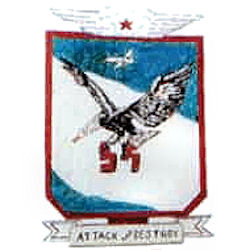|
453rd Bombardment Group
The 453rd Bombardment Group is an inactive United States Air Force unit that was first organized in June 1943, during World War II, as a Consolidated B-24 Liberator heavy bomber group. After training in the United States, it deployed to England in December 1943, and, starting in February 1944, participated in the strategic bombing campaign against Germany with Eighth Air Force. Its 733d Bombardment Squadron completed 82 consecutive missions without a loss, a record for Eighth Air Force bomber units. James Stewart, of film fame, was group operations officer from 31 March to 1 July 1944. The group was programmed for redeployment to the Pacific and returned to the United States in May 1945 for training, however the Japanese surrender cancelled these plans and the group was inactivated in September 1945. The group was redesignated the 453rd Operations Group and activated at Fairchild Air Force Base in June 1992 to command Air Mobility Command (AMC)'s air refueling units at Fair ... [...More Info...] [...Related Items...] OR: [Wikipedia] [Google] [Baidu] |
B-24 Liberators
The Consolidated B-24 Liberator is an American heavy bomber, designed by Consolidated Aircraft of San Diego, California. It was known within the company as the Model 32, and some initial production aircraft were laid down as export models designated as various LB-30s, in the Land Bomber design category. At its inception, the B-24 was a modern design featuring a highly efficient shoulder-mounted, high aspect ratio Davis wing. The wing gave the Liberator a high cruise speed, long range and the ability to carry a heavy bomb load. Early RAF Liberators were the first aircraft to cross the Atlantic Ocean as a matter of routine. In comparison with its contemporaries, the B-24 was relatively difficult to fly and had poor low-speed performance; it also had a lower ceiling and was less robust than the Boeing B-17 Flying Fortress. While aircrews tended to prefer the B-17, General Staff favored the B-24 and procured it in huge numbers for a wide variety of roles. At approximately 18,50 ... [...More Info...] [...Related Items...] OR: [Wikipedia] [Google] [Baidu] |
Air Combat Command
Air Combat Command (ACC) is one of nine Major Commands (MAJCOMs) in the United States Air Force, reporting to Headquarters, United States Air Force (HAF) at the Pentagon. It is the primary provider of air combat forces for the Air Force, and it is the direct successor to Tactical Air Command. Air Combat Command is headquartered at Langley Air Force Base, Joint Base Langley–Eustis, Virginia, United States. ACC directly operates 1,110 fighter, attack, reconnaissance, combat search and rescue, airborne command and control and electronic aircraft along with command, control, computing, communications and intelligence (C4I) systems, Air Force ground forces, conducts global information operations, and controls Air Force Intelligence. Air Combat Command consists of approximately 74,240 active duty Airmen and 10,610 Department of the Air Force Civilians. When mobilized, more than 49,000 additional Airmen of the Air Force Reserve and the Air National Guard, along with over ... [...More Info...] [...Related Items...] OR: [Wikipedia] [Google] [Baidu] |
Oil Refineries
An oil refinery or petroleum refinery is an industrial process plant where petroleum (crude oil) is transformed and refined into useful products such as gasoline (petrol), diesel fuel, asphalt base, fuel oils, heating oil, kerosene, liquefied petroleum gas and petroleum naphtha. Petrochemicals feedstock like ethylene and propylene can also be produced directly by cracking crude oil without the need of using refined products of crude oil such as naphtha. The crude oil feedstock has typically been processed by an oil production plant. There is usually an oil depot at or near an oil refinery for the storage of incoming crude oil feedstock as well as bulk liquid products. In 2020, the total capacity of global refineries for crude oil was about 101.2 million barrels per day. Oil refineries are typically large, sprawling industrial complexes with extensive piping running throughout, carrying streams of fluids between large chemical processing units, such as distillation co ... [...More Info...] [...Related Items...] OR: [Wikipedia] [Google] [Baidu] |
Altenbeken
Altenbeken () is a municipality in the Paderborn (district), district of Paderborn, in North Rhine-Westphalia, Germany. Geography Altenbeken is situated in the Eggegebirge, approx. 15 km northeast of Paderborn. To the west of the town is the Altenbeken Viaduct, a railway bridge that spans the Beke valley. Division of the municipality Altenbeken consists of the following 3 districts * Altenbeken * Buke * Schwaney International relations Altenbeken is town twinning, twinned with: * Betton, Ille-et-Vilaine, Betton (near Rennes), (France) References External links Official site Paderborn (district) {{Paderborn-geo-stub ... [...More Info...] [...Related Items...] OR: [Wikipedia] [Google] [Baidu] |
Big Week
Big Week or Operation Argument was a sequence of raids by the United States Army Air Forces and RAF Bomber Command from 20 to 25 February 1944, as part of the European strategic bombing campaign against Nazi Germany. The planners intended to attack the German aircraft industry to lure the ''Luftwaffe'' into a decisive battle where the Luftwaffe could be damaged so badly that the Allies would achieve air superiority which would ensure success of the invasion of continental Europe. The joint daylight bombing campaign was also supported by RAF Bomber Command operating against the same targets at night. Arthur "Bomber" Harris resisted contributing RAF Bomber Command so as not to dilute the British "area bombing" offensive. It took an order from Air Chief Marshal Sir Charles Portal, Chief of the Air Staff, to force Harris to comply. RAF Fighter Command also provided escort for USAAF bomber formations, just at the time that the Eighth Air Force had started introducing the P ... [...More Info...] [...Related Items...] OR: [Wikipedia] [Google] [Baidu] |
Tours
Tours ( , ) is one of the largest cities in the region of Centre-Val de Loire, France. It is the prefecture of the department of Indre-et-Loire. The commune of Tours had 136,463 inhabitants as of 2018 while the population of the whole metropolitan area was 516,973. Tours sits on the lower reaches of the Loire, between Orléans and the Atlantic coast. Formerly named Caesarodunum by its founder, Roman Emperor Augustus, it possesses one of the largest amphitheaters of the Roman Empire, the Tours Amphitheatre. Known for the Battle of Tours in 732 AD, it is a National Sanctuary with connections to the Merovingians and the Carolingians, with the Capetians making the kingdom's currency the Livre tournois. Saint Martin, Gregory of Tours and Alcuin were all from Tours. Tours was once part of Touraine, a former province of France. Tours was the first city of the silk industry. It was wanted by Louis XI, royal capital under the Valois Kings with its Loire castles and c ... [...More Info...] [...Related Items...] OR: [Wikipedia] [Google] [Baidu] |
Airfield
An aerodrome (Commonwealth English) or airdrome (American English) is a location from which aircraft flight operations take place, regardless of whether they involve air cargo, passengers, or neither, and regardless of whether it is for public or private use. Aerodromes include small general aviation airfields, large commercial airports, and military air bases. The term ''airport'' may imply a certain stature (having satisfied certain certification criteria or regulatory requirements) that not all aerodromes may have achieved. That means that all airports are aerodromes, but not all aerodromes are airports. Usage of the term "aerodrome" remains more common in Ireland and Commonwealth nations, and is conversely almost unknown in American English, where the term "airport" is applied almost exclusively. A water aerodrome is an area of open water used regularly by seaplanes, floatplanes or amphibious aircraft for landing and taking off. In formal terminology, as defined by ... [...More Info...] [...Related Items...] OR: [Wikipedia] [Google] [Baidu] |
RAF Old Buckenham
Royal Air Force Old Buckenham (RAF Old Buckenham) is a former Royal Air Force station located south east of Attleborough, Norfolk, England which was used during the Second World War by the United States for the strategic bombing campaign against Germany. The airfield is in civilian use as Old Buckenham Airport. At the centre of the modern-day airfield is a black granite memorial to the 366 United States Army Air Force (USAAF) servicemen who died serving from the base in the Second World War. The airfield mainly handles General Aviation traffic. A 1941 Boeing Stearman operates from the airfield and a 1943 D Day veteran Piper J-3 Cub is also based at the field. The airfield has adopted a shield carved in wood by a serving USAAF officer at the base during the war as its logo. History USAAF use Old Buckenham airfield was built during 1942–43 for the USAAF Eighth Air Force. It was given designation USAAF Air Station 144. 453rd Bombardment Group (Heavy) The airfield was ... [...More Info...] [...Related Items...] OR: [Wikipedia] [Google] [Baidu] |
March Field
March is the third month of the year in both the Julian and Gregorian calendars. It is the second of seven months to have a length of 31 days. In the Northern Hemisphere, the meteorological beginning of spring occurs on the first day of March. The March equinox on the 20 or 21 marks the astronomical beginning of spring in the Northern Hemisphere and the beginning of autumn in the Southern Hemisphere, where September is the seasonal equivalent of the Northern Hemisphere's March. Origin The name of March comes from ''Martius'', the first month of the earliest Roman calendar. It was named after Mars, the Roman god of war, and an ancestor of the Roman people through his sons Romulus and Remus. His month ''Martius'' was the beginning of the season for warfare, and the festivals held in his honor during the month were mirrored by others in October, when the season for these activities came to a close. ''Martius'' remained the first month of the Roman calendar year perhaps as l ... [...More Info...] [...Related Items...] OR: [Wikipedia] [Google] [Baidu] |
Pocatello Army Air Field
Pocatello Regional Airport is a city-owned, public-use airport located seven nautical miles (13 km) northwest of the central business district of Pocatello, a city in Bannock County, Idaho, United States. The airport is built on the site of the Pocatello Army Airfield, a World War II training base. Many of the base facilities have been razed, although four large hangars remain. The airport is also the home to the National Weather Service Pocatello Office. As per the Federal Aviation Administration, this airport had 25,756 passenger boardings (enplanements) in calendar year 2008, 21,039 in 2009, and 20,825 in 2010. The National Plan of Integrated Airport Systems for 2011–2015 categorized it as a '' primary commercial service'' airport. The airport is home to the Kizuna Garden, built to commemorate the bond between Pocatello and its sister city Iwamizawa. Facilities and aircraft Pocatello Regional Airport covers an area of 3,374 acres (1,365 ha) at an elevation o ... [...More Info...] [...Related Items...] OR: [Wikipedia] [Google] [Baidu] |
735th Bombardment Squadron
The 735th Bombardment Squadron is a former United States Army Air Forces unit. It was assigned to the 453d Bombardment Group and last stationed at Fort Dix Army Air Base, New Jersey, where it was inactivated on 12 September 1945. The squadron was first activated in May 1943. After training in the United States with the Consolidated B-24 Liberator, the squadron deployed to the European Theater of Operations, participating in the strategic bombing campaign against Germany. Following V-E Day, the squadron returned to the United States for conversion as a very heavy bomber unit, but inactivated instead. History Training in the United States The 735th Bombardment Squadron was activated at Wendover Field, Utah as one of the four squadrons of the 453d Bombardment Group. It moved to Pocatello Army Air Field, Idaho, where it was brought up to strength and trained with Consolidated B-24 Liberators. It completed its training at March Field, California in December and departed for t ... [...More Info...] [...Related Items...] OR: [Wikipedia] [Google] [Baidu] |





